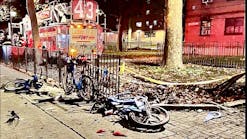Harvey Eisner Remembered at 'The Rock'
Source Firehouse.com News
THE ROCK – Laughter, hugs, handshakes, lots of stories mixed with good food – just the kind of event Harvey Eisner loved.
And, that’s just how more than 200 celebrated Eisner Saturday at the FDNY Training Center (The Rock).
Honorary FDNY assistant chief and longtime editor of Firehouse Magazine, Eisner died Oct. 23. He was 59.
A devastating knee injury shattered his life-long dream of becoming a member of the FDNY, but it didn’t stop him from pursuing his passion.
While his FDNY buddies were hauling hoses, climbing ladders and making rescues, he was aiming his lens.
Not only did he capture dramatic images, he sat with the heroes with notebook in hand to document the incident.
And, he didn’t stick to well-known territory either. It didn’t matter where it happened. Eisner would be there eventually to listen to firefighters’ challenges, fears, joy and sorrow in order to let the public know.
“Harvey spent much time capturing the essence of the fire service,” retired FDNY firefighter John Norman said, struggling to find the right words.
Harvey was a regular at Rescue 3 where he not only had a seat at the table, but was known to be the victim of firehouse pranks.
One of his proudest moments was when they designated him an honorary FDNY assistant chief, his fellow firefighters recalled Saturday.
He realized that firefighters should be sharing their expertise. But, he found that some would take strong encouragement.
That wasn’t the case, however, with retired FDNY Lt. Mike Wilbur.
But, Wilbur said his dream of becoming a writer was nearly drowned – thanks to fellow firefighters.
Wilbur was devastated when an editor of another fire service magazine turned him down on his offer to write about emergency vehicle operations. Fellow firefighter, Mickey Conboy, suggested he call Harvey.
He didn’t.
Harvey called him, and set up a meeting. “…I proceeded to go home and typed up 53 column headings…” Wilbur told the crowd.
He anxiously waited for him to arrive at his firehouse.
“As Harvey was walking up to meet me, someone let a bucket of water go off of the firehouse roof and hit Harvey Eisner, the icon of the fire service, square in the head. Water dripped from the two pagers on his right hip and the two scanners on his left hip, and as he walked toward me water was streaming under pressure out of the air holes in his PF Flyers. I was truly mortified…”
After he dried off, the two sat down and discussed the story ideas. Wilbur said it was the beginning of a “beautiful friendship.”
Wilbur added with a laugh that in his college English class he would have been voted ‘the least likely to write or present anything on a national stage.’
In the Firehouse magazine office, Harvey was known to answer a question with a line from his favorite movie, ‘Miracle on 34th Street.’
“He had watched it hundreds of times, and knew every line,” recalled Jeff Barrington, associate publisher.
Harvey was more than a co-worker of Barrington’s. He was like a brother.
His advocacy on behalf of the nation’s fire service also was remembered by the Congressional Fire Services Caucus.
“Harvey leaves behind an incredible legacy within the fire service. He was widely respected for his commitment and dedication to firefighter health and safety. It was reflected in his work...” wrote Congressman Bill Pascrell Jr.
“…He was a pensive man who was always willing to share his thoughts and ideas on how the federal government can better serve our nation’s first responders…”
A flag flown over the U.S. Capitol in his honor was presented to his mother, Carol Eisner.
A tearful Mrs. Eisner received a standing ovation after thanking the crowd, especially the FDNY firefighters, for their love and continued support.
National Fire Academy Superintendent Dr. Denis Onieal spoke of Eisner’s contributions.
“Like the impeller in a fire pump, Harvey was always pushing – sometimes the volume, sometimes pressure – but always in action, always moving. Instead of water, Harvey pushed new knowledge, great operations. Lessons learned and bad experiences into our profession at different speeds and places, accomplishing all sorts of miracles…”
Onieal added: “Through emotive prose and vivid, graphic images, Harvey Eisner pushed, pulled demonstrated, instigated, led and inspired America’s fire and emergency services in ways few can ever comprehend, appreciate or duplicate.”









